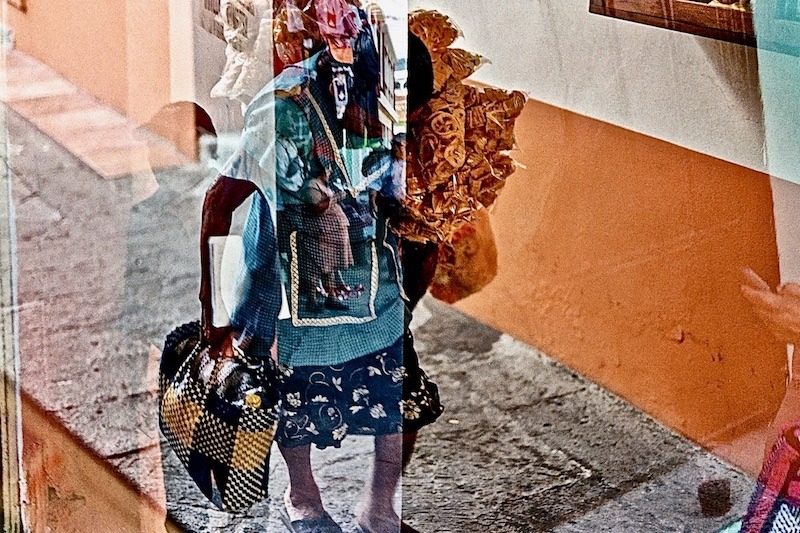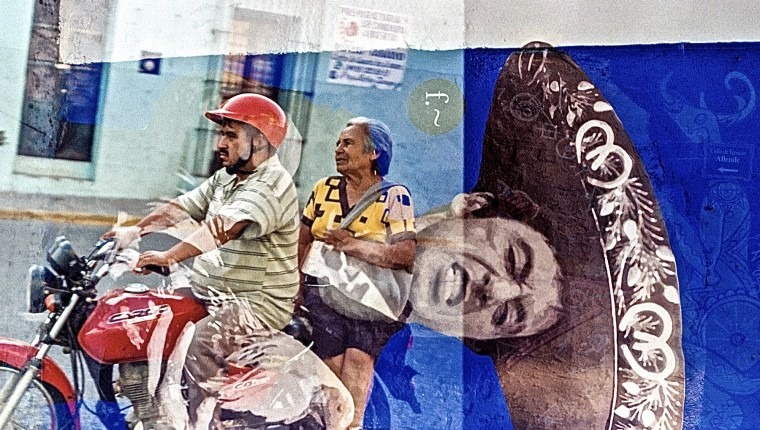A friend of mine, a local photographer, and I were brainstorming a name for a new photography magazine. Back and forth, in a cafe, the math of verbal volley. No luck but lots of laughter and learning each other’s art sense, art spirit and art taste until one day while reading Italo Calvino’s short story “The Adventure of a Photographer,” I came across a sentence that began, “I’d like to have one of those old box cameras,” and voila, accident and aim, we settled on Old Box for the name of our still yet to be born magazine.
Optic and oral, a good camera walk is like a physical folktale, a trek through the tropes of human interaction, the raw architectural spaces between he say she say, the climate change of outrageous rumors. In this series of Artist Stories, ever so slyly, like a shutter winking at a passerby, I’d like to create an exchange with Calvino’s short story, and share images from my own adventures in photography, past and present, many of which are the offerings of invisible cities and the growing isolation that I have come to inhabit in those foto-sensitive intervals of self-reflection, the seconds between the finger-thought of buying a body from a soul. Subjects willing, subjects unwilling. Warning: I will not blink when encountering the false boundaries between prosody, prose, and photographic essay. The work is pre-mix, mix and remix, a magnetic trinity of images that run on, run into, and run over one another like ghosts at a crowded rest stop––the percussive continuance, the juxtaposition of the metaphors of public awareness, a grammatical layering; the non-fictitious gestures of those who know they are being photographed, their organic costumes, sublime personas, nervous parodies, and parade of poses. All as silent as the sin of sound, our loud earthly cinema, one century muting another. Worried, I am, usually by two cameras: one for daydreams, the other for nightmares.

Calvino’s story begins on a Sunday with hundreds and thousands of city inhabitants filling the streets and photographing one another. “As happy as hunters” is how he describes them. My echo, the one I am choosing to open this old box of prosody framed as prose with, also begins on a Sunday on a dark street in Oaxaca, Mexico, in 2018, where after a long camera walk, observing strangers, and reading the literacy of facial expressions mostly eclipsed by tolerance and straw hats, I stepped off a very high curb (without looking) and broke a small bone in my right foot, jamming my film camera and preventing it from advancing more than three frames at a time and having to rewind the roll numerous times. Frame border in the wrong place, raggedy folk edges, graphic and grainy photographic painting, the overlapping, lens change, the guessing, lens change, the letting go, the intrigue of a whole trip of poetic mess!

All improvisation, both skilled and unskilled chance, the counterclockwise then clockwise conning of the lever at the top of the camera body, an eye rolling in the view finder, no comfortable rhythm, no photographic groove, ease, no time for a repair, no way to replace the camera on my travel budget. I had a month and other cities to visit. Swollen, bulbous and blue, my foot was no stranger to the bell tower of Hugo’s cathedral. Even my Esmeralda was tired of helping me with my Spanish. Si for yes. Sacapuntas for pencil sharper. Sientate ojos for sit down eyes but not much else. Time, I told myself, to think about movement differently. Ace bandage, one crutch or none? No caste. Time to limp like a bent lens through color, Casa Azul, then the glint of sliver gelatin, but not quite the ice pick of pain that killed Trotsky. Fuss, I could, with the contrasting layers, the tension of focal length, the grayscale of necessary distance, all gathered like a protest in the overexposed black and white. I had three rules: lean against a building for support, shoot before and after the picture saw me, and every so often sit and remove my shoe so my foot could breathe, shrink through throb.




